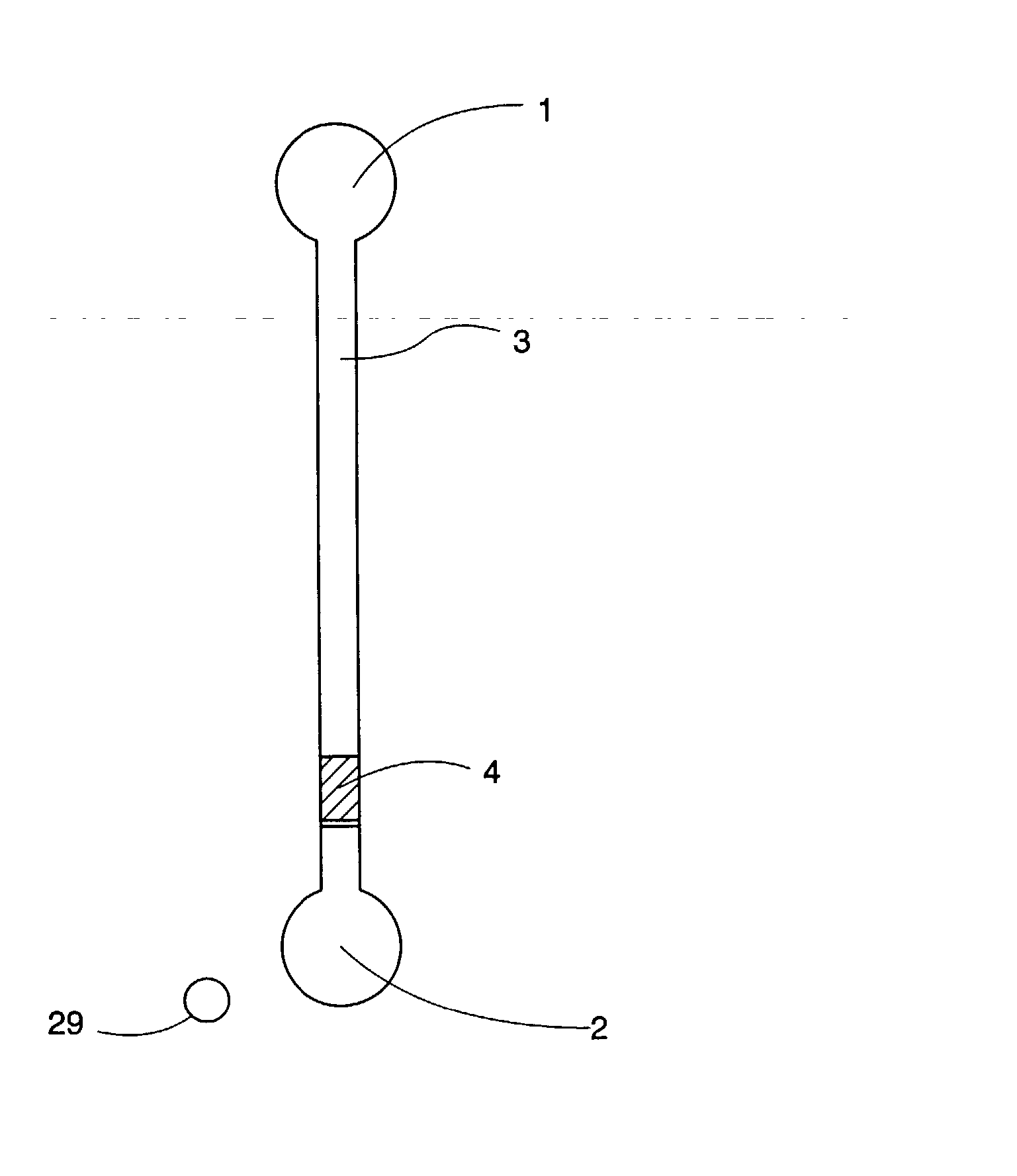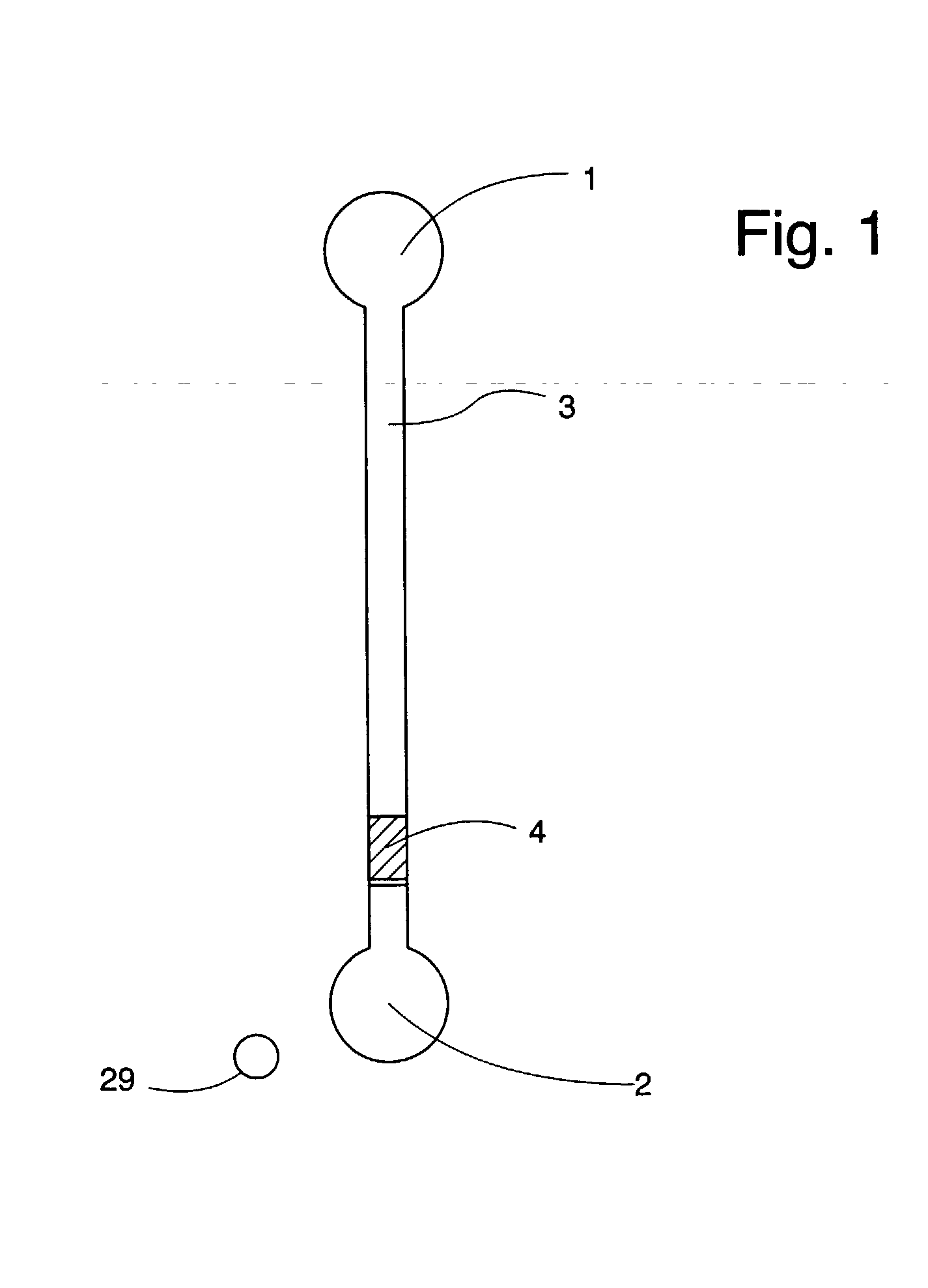Microfluidic devices and methods
a technology applied in the field of microfluidic devices and methods, can solve the problems of imposing an extra complexity on the design and use, negatively affecting production costs, and easiness of handling etc. of these devices
- Summary
- Abstract
- Description
- Claims
- Application Information
AI Technical Summary
Benefits of technology
Problems solved by technology
Method used
Image
Examples
example 2
Planar CD and Structured Removable Lid
[0185] This example shows a planar CD in combination with a lid in which the microfluidic structures are present. The structured lid was achieved through casting Memosil (Hereaus, Germany) against a nickel-coated master. The microfluidic structure employed in this example is shown in FIG. 2.
[0186] The structured lid is attached to the CD by adhesion forces. The surface facing the lid should be hydrophilic as the presented invention utilizes capillary action to fill the microfluidic structures. This is especially important as the moulded lid, being a type of silicon rubber is hydrophobic.
[0187] The upper side of the CD was covered with gold using a DC Bias magnetron sputtering method (1*10-5 torr, Ar plasma and titan as adhesion layer) and made hydrophilic according to the following procedure; The gold sputtered side was cleaned by rinsing with ethanol, followed by an oxygen plasma treatment (Plasma Science PSO500,). After plasma cleaning a self-...
example 3
Structured CD and Site-Specific Elution
[0193] This example employs a CD with integrated microfluidic structures, a thin (.ltoreq.70 .mu.m) lid with holes at positions matching the MALDI port in the CD. The microfluidic structure employed in this example is shown in FIG. 1.
[0194] The polycarbonate CD was covered with gold as described above. The side was hydrophilized using the thiolprocedure described above. The lid (SkultunaFlexible, Skultuna, Sweden), having, pre-drilled holes, was attached to the CD through heat pressing at 135.degree. C.
[0195] Reversed phase beads (Source 15 RPC) with a diameter of 15 .mu.m were packed in the individual structures using capillary forces in combination with centrifugation. The columns were rinsed with ethanol and spun to dryness before 23 fmol of tryptically digested BSA was added and spun down using 700 rpm. The tryptic digest of BSA was generated according to the procedure described above. After sample addition, the column was rinsed twice with...
example 4
Parallel Sample Preparation in a Product CD
[0197] Description of the Microfluidic Disc (CD)
[0198] FIG. 8a illustrate a product microfluidic device (CD) (1000) comprising 10 sets (1001) of identical microchannel structures (1002) arranged annularly around the spinning axis (axis of symmetry) (1003) of a circular disc (1000). Each set comprises 10 microchannel structures. Each microchannel structure is oriented radially with an inlet port (1004,1005) located at shorter radial distance than an outlet port (MS-port) (1006). The MS-ports are 0.9 cm from the edge of the disc (not shown). The disc was of the same size as a conventional CD. The CD has a home mark (1035) at the edge (1036) for positioning the disc when dispensing liquids.
[0199] The final device comprises a bottom part in plastic material that contains the uncovered form of the microchannel structures given in FIG. 8a. The microchannel structures are covered with a lid in which there are circular holes (1007,1008,1009,1010,10...
PUM
| Property | Measurement | Unit |
|---|---|---|
| width | aaaaa | aaaaa |
| width | aaaaa | aaaaa |
| distance | aaaaa | aaaaa |
Abstract
Description
Claims
Application Information
 Login to View More
Login to View More - R&D
- Intellectual Property
- Life Sciences
- Materials
- Tech Scout
- Unparalleled Data Quality
- Higher Quality Content
- 60% Fewer Hallucinations
Browse by: Latest US Patents, China's latest patents, Technical Efficacy Thesaurus, Application Domain, Technology Topic, Popular Technical Reports.
© 2025 PatSnap. All rights reserved.Legal|Privacy policy|Modern Slavery Act Transparency Statement|Sitemap|About US| Contact US: help@patsnap.com



